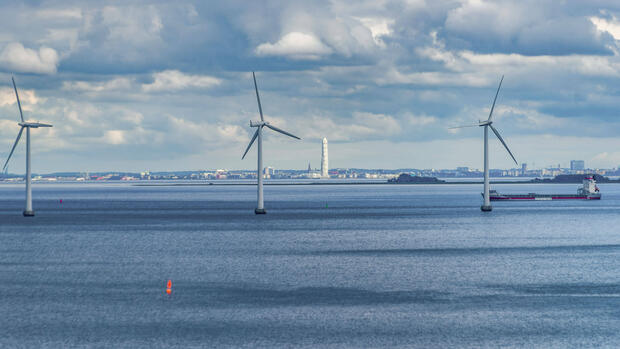Close cooperation between the North Sea and Baltic Sea countries is one of the basic requirements for achieving the EU’s ambitious goals for the expansion of offshore wind power.
(Photo: IMAGO/CHROMORANGE)
Berlin Germany and Denmark are jointly expanding the infrastructure for offshore wind power. Federal Economics Minister Robert Habeck (Greens) and Danish Energy Minister Lars Aagaard signed a legally binding cooperation agreement on Thursday. A ministry spokeswoman confirmed this to the Handelsblatt.
According to the Federal Ministry of Economics, this is the first agreement of this kind in the EU. Minister Habeck said that the project creates the basis for future green electricity imports to Germany and will “make the power supply cheaper, safer and less dependent on fossil fuels”.
Close cooperation between the North Sea and Baltic Sea countries is one of the basic requirements for achieving the EU’s ambitious goals for the expansion of offshore wind power. According to EU plans, wind farms with a capacity of 300 gigawatts (GW) are to be installed in the North Sea alone by 2050. In 2030 it should be 120 GW. According to the plans of the federal government, 30 GW of wind power is to be installed in the German part of the North Sea and the Baltic Sea by 2030.
With the 300 GW of installed offshore wind capacity in the North Sea, around a third of the current electricity consumption in the EU could be covered. The prerequisite, however, is that the corresponding network infrastructure is created. So far, the electricity from several offshore wind farms has been collected and then transported to the coast of the country to which the farms belong.
The Europeans are striving to network offshore wind farms internationally in the future. The advantages are obvious: if a country can no longer use electricity sensibly on windy days, a buyer can probably be found elsewhere in north-western Europe. Overall, the liquidity of the electricity markets can increase, the electricity price level can fall and security of supply can increase.
Bornholm becomes a hub for wind power
With the cooperation agreement, the governments of Germany and Denmark are now creating the prerequisites for transnational cooperation in the Baltic Sea. In March, the member states agreed on a new EU directive for renewable energies.
It also regulates cross-border projects. Accordingly, each member state must develop a binding legal framework for cross-border cooperation projects so that joint cooperation is strengthened.
Denmark and Germany have now met this EU requirement with the agreement. It regulates, for example, that half of the electricity generated is counted towards the EU targets for the share of renewables in electricity generation.
On the Danish Baltic Sea island of Bornholm, at least three GW of offshore wind power generation capacity is to be connected to Danish territory by the early 2030s. The electricity will then be transported to Germany and the Danish mainland via new grid connections.
The German transmission system operator 50Hertz and the Danish transmission system operator Energinet agreed in advance that they would each assume half of the infrastructure costs of the project. In return, they each receive ownership of the grid connection to the respective mainland.
>>Read here: Tennet awards 30 billion offshore grid contracts
50Hertz and Energinet have been working on the project for years and are considered pioneers. With the government agreement, the legal framework for the two companies has become more concrete. In the medium term, they want to turn Bornholm into a hub for the distribution of electricity from offshore wind turbines. In this way, Bornholm could become the blueprint for similar projects.
Further projects in the North Sea and Baltic Sea are on the horizon
The two companies refer to their project as “Bornholm Energy Island”. The island is to become an “offshore hub”, i.e. a hub for the surrounding wind farms in both countries. 50Hertz and Energinet had already inaugurated the first cable in 2020 that connects German and Danish wind farms together.
In the medium term, Bornholm is to become a hub for the distribution of electricity from offshore wind turbines.
(Photo: obs)
With the Bornholm Energy Hub, they now want to go one step further and implement the first real power grid node for the Baltic Sea. The centerpiece is a direct current connection between the two countries that is more than 400 kilometers long. Bornholm is located in the geographical middle of the connection. Converters, substations and a terminal for the distribution of electricity are also to be built there.
But that is only the beginning. In the future, for example, offshore wind farms with up to ten GW will be connected to Germany and other countries via new power lines in another Danish energy hub in the North Sea. Further cooperation projects are also emerging in the Baltic Sea.
More: How the North Sea is to become the largest power plant in the world
